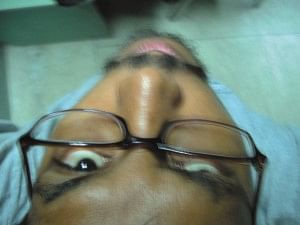
By Ferzeen Anis
Photography happens to be the latest, most happening career option for the youths of Bangladesh. Everywhere you look, you are bound to find an upcoming, or a professional photographer snapping away at different locations around the city. Search among your friends and family, and you are almost 100% certain to meet one of these aspiring artists. In this article, I intend to let you know some more about photography as both, a hobby and a career and answer a few questions you may have.
What makes photography so interesting a career choice, you ask? Well, photography is simply the photographer's personal expression of art and beauty (and sometimes, ugliness). And as not all the people in this world are blessed with a skill like Picasso's to vent their feelings on canvas; some choose fashion designing, interior designing, architecture, etc. as their medium of expression. Others choose photography.
More often than not, the pursuing of photography professionally, evolves from a prior hobby of taking snapshots. Some professionals and amateurs say that even when they were toddlers, they had an inane urge to click away with all their might, at that absolutely wonderful thingamajig called a camera. Others believe they realized their passion during their ripe, teen years, and their raging hormones may have been the reason for the random shots taken at bizarre angles (which, coincidentally, usually produced quite good results).
 Even if one is not interested in photography as a career, it really is an extremely interesting, creative and motivating hobby. You don't have to have the high-tech digital camera and lighting equipment to go after photography. "You don't even have to know about things called 'depth' and 'focus' initially", says one pro photographer. "What really matters in the beginning is your thirst for embracing photography with extreme passion. And when I say extreme, I mean EXTREME. Photography is an activity that you can't help but love with a passion unmatched, if you're devoted to it."
Even if one is not interested in photography as a career, it really is an extremely interesting, creative and motivating hobby. You don't have to have the high-tech digital camera and lighting equipment to go after photography. "You don't even have to know about things called 'depth' and 'focus' initially", says one pro photographer. "What really matters in the beginning is your thirst for embracing photography with extreme passion. And when I say extreme, I mean EXTREME. Photography is an activity that you can't help but love with a passion unmatched, if you're devoted to it."
Primarily, one's commitment to taking photographs develops when one realizes the variety with which one can express one's views and opinions, and have no one to answer for it. Unlike the hard work and strain that goes into painting and designing, during photography, the beauty is there, readymade for you to capture it in any way you want to. All you have to do is load a camera with a film (or not, if it is a digital camera) and look for a site or figure to take photographs of. Neither do you need landscapes like that of Kashmir and Switzerland, nor do you need models with figures like Angelina Jolie, Aishwarya Rai, Salman Khan or Arjun Rampal. The only requirement is the ability to look for beauty, or even desperateness, in what is around you and have a great time. No matter what the outcome, you will always have a personal reason for taking a photograph of 'the tree from that weird angle' or 'that absurd bird's eye view of the city'. It's all fun and 'clicking'!
Of course, there is no hiding the fact that photography is an expensive hobby. Especially if you're tired of churning out not-so-good quality photographs, and want to move ahead and explore the art further. This is the first recognizable step of considering photography as a profession. The purchase of a good quality camera is a big deal in itself, particularly if you parents are of the usual kind who regard photographers as some 'lonely wanderers', and are not exactly eager to spend bundles of money on ' a useless camera'. Unfortunately, as luck would have it, the people with rolls of money usually have no interest in the art. It's just another irony of life (life sucks sometimes, doesn't it?).
While you don't also have to buy all the lighting equipment, you may have to consider doing so after practicing some more shots with a better quality camera. To learn more of the 'photography language', you can start attending courses, or workshops held by universities, or go and view some of the many photograph galleries and exhibitions around the city. Then you may learn to, or personally decide to, concentrate on particular subjects to photograph, even if you're not sure about it as a career. Most photographers say that a single photographer cannot be a master of all the subjects. You may choose between lifestyle, landscape, nature, urban areas, portraits, etc. Try the different types out one at a time, so you can really concentrate on the subject while you're experimenting. And once you get the finished results, it's easy for you to decide which subject you most enjoy photographing, and have a skill for.
You don't have to worry about the expensive lenses, and darkrooms, chemicals, etc. necessary for a professional photographer. It is best if you develop this art through the years. This may sound like a long time, but trust me it's worth it. Any other amateur or professional will say the same. It's important to fully enjoy the hobby as an amateur, before taking up a more mature approach. It doesn't matter if you don't have an inborn talent; this is something you can learn to be good at.
I guess I've still left quite a few questions unanswered for those of you aspiring to be photographers, especially regarding the equipment. No sweat. Look out for the follow up next week it'll contain further details and advice from a professional. Until then, it's ciao from me, and a word of advice to the many teens out there give photography a try, or you may be missing out on an absolutely wonderful hidden talent!
Pebbles From The Past
By Tausif Salim
I used to collect lots of stuff when I was a kid. Although I haven't quite managed to grow out of kid-hood, the fascination for every other collectible isn't there anymore. These days those items occupy old drawers, decorated by cobwebs and cockroach poo.
One of the earliest things I started collecting are Tazos. Remember those circular plastic things which came free with potato chips? Till this day Tazos continue to fascinate me, just because of their ingenuity. Only the Japanese know how to turn a small, simple piece of plastic into a craze that's been rocking kids till today.
The Tazo fever for me was short-lived, as they proved rather expensive to collect. So next, I switched to tattoos. Tattoos came free with every other chewing-gum, and the designs ranged to …well almost everything. A lot of kids were seen plastering their limbs with whatever that came in the gum packet. I still have an entire collection of cricketer tattoos which I specially preserved at that time.
When the cricket world cup started, naturally our attention got diverted to more cricket-ish stuff. There was a massive craze at that time of collecting cricket cards. Many of my friends managed to get the whole collection of some 100 odd cards, (for which they had to buy some 100 odd Pepsi bottles!). Other than just cricket cards, many of us used to collect wrestling trading cards. I have no idea how today's smarter and more mature generation got into something as absurdly childish as Pokèmon.
Let's move on before the Pokè
mon fans curse me to death. Amongst every other thing that I collected, stickers were my largest lot. In school we used to bring our sticker albums and exchange them during recess. We had a fierce competition amongst cousins on who could collect the most number of stickers. These days the only use I have for them is to stick them on my student's copies. The awe in their faces somewhat remind me of my own at their age.
It's amazing how these tiny things of our tiny lives lose their meaning in a short span of time. The innocent world of stickers and Tazos are replaced by more serious stuff, stuff that bring a new level of joy, not to mention the free set of worries with them. Sometimes the stress makes me want to go back to that world again, just for a moment… and then the thought turn to a smile, and I move on. Those items continue to remain as tokens of bygone times. A Pensieve of a childhood enriched with countless fond memories.
